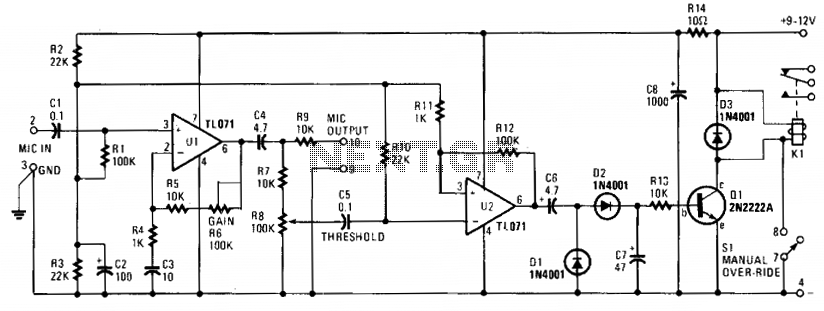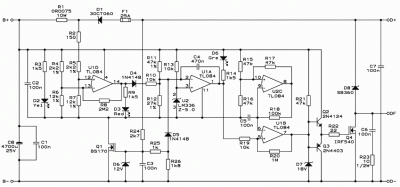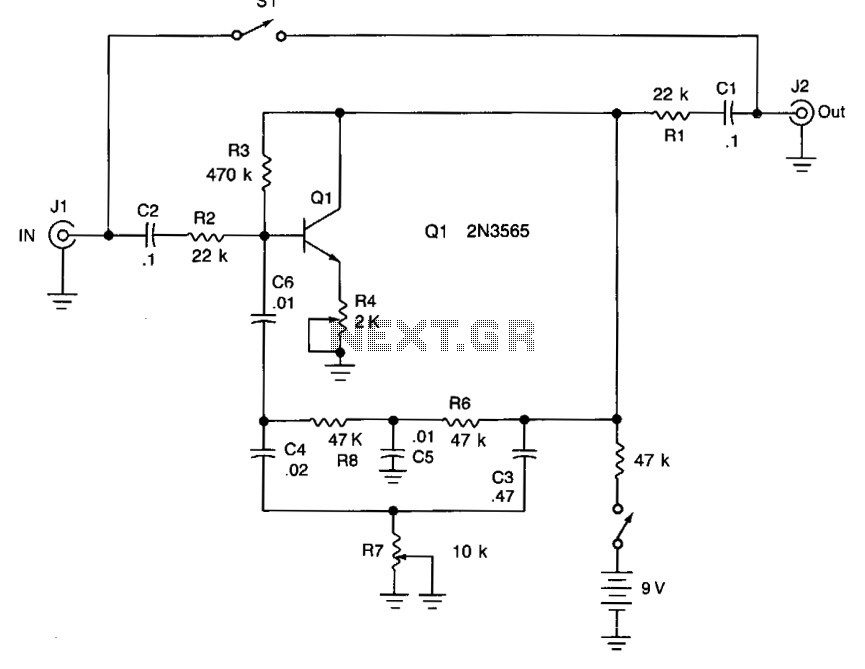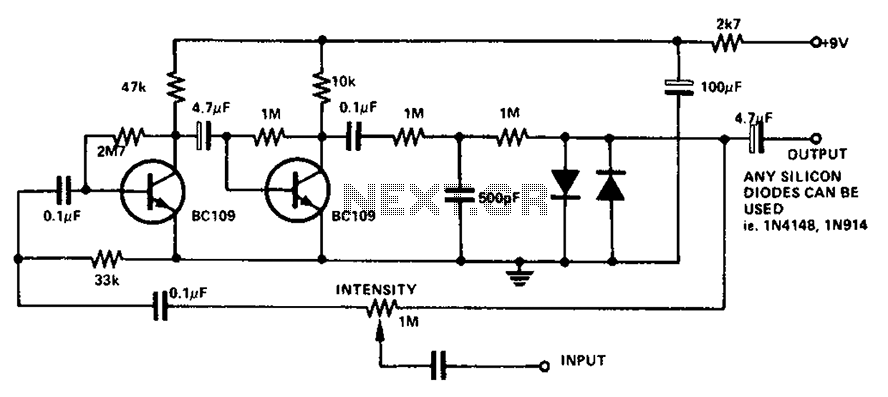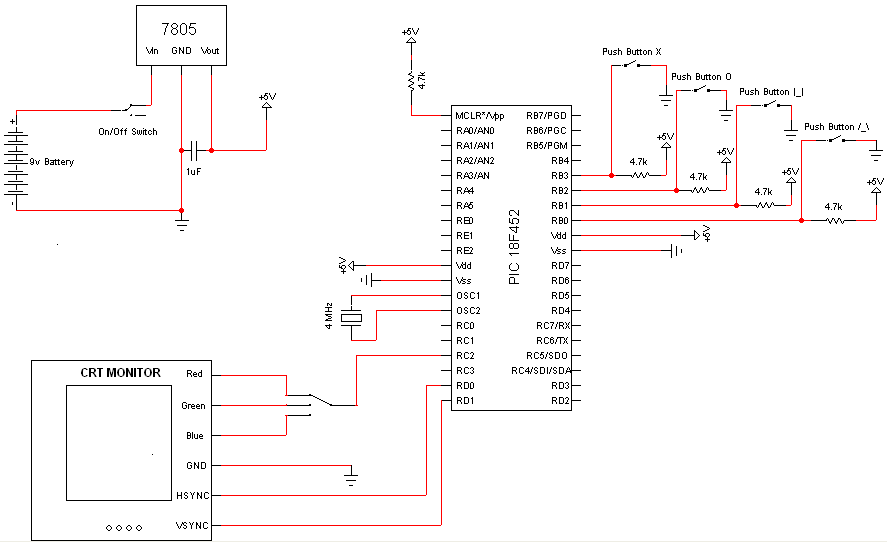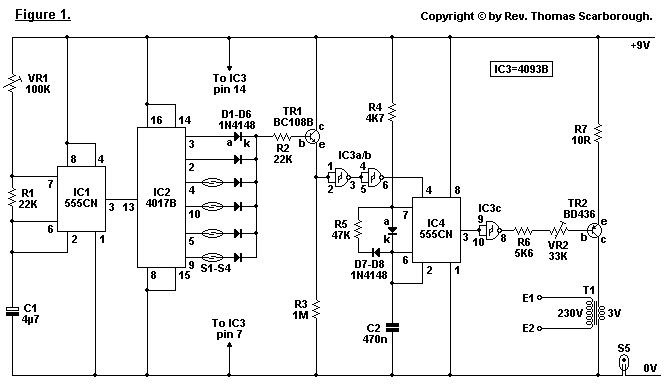
Fuzz box 3
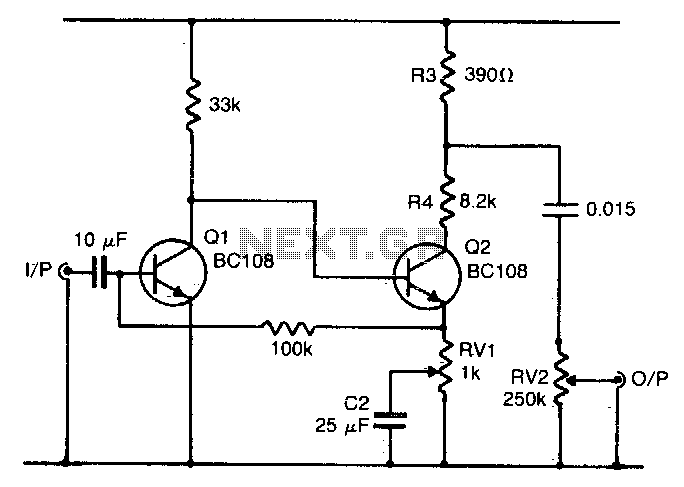
Q1 and Q2 form a voltage amplifier that provides sufficient gain to be overdriven by a relatively low input, such as an electric guitar. The output from Q2 is a squared-off version of the input, resulting in the desired fuzz sound. RV1 adjusts the amount of negative feedback introduced into the circuit by C2, thereby controlling the degree of signal squaring. The function of R3 and R4 is to reduce the output voltage to an appropriate level, which can then be fine-tuned with the volume control VR2.
The circuit utilizes two transistors, Q1 and Q2, configured as a cascading voltage amplifier. The input from an electric guitar connects to the base of Q1, where it is amplified. The amplified signal is then fed into Q2, which further amplifies the voltage. The distortion characteristic, or fuzz effect, is achieved through the nonlinear response of the transistors when overdriven, producing a squared waveform at the output.
The feedback mechanism in the circuit is managed by RV1, a variable resistor that adjusts the amount of negative feedback provided by capacitor C2. By varying RV1, the user can control how much of the output signal is fed back to the input, which influences the degree of distortion and the tonal characteristics of the output signal. A higher negative feedback results in less distortion, while lower feedback allows for more aggressive squaring of the waveform.
Resistors R3 and R4 play a critical role in managing the output level. They are configured to form a voltage divider, ensuring that the signal output from Q2 is reduced to a level that is compatible with subsequent stages in the signal chain, such as additional amplifiers or effects pedals. The volume control, VR2, provides the final adjustment to the output level, allowing the user to set the desired loudness without introducing additional distortion.
This configuration is particularly effective for electric guitars, as it enhances the harmonic content of the signal while providing the characteristic fuzz sound that many guitarists seek. The overall design emphasizes simplicity and effectiveness, ensuring that the circuit can be easily integrated into a variety of musical setups.Q1 and Q2 form a voltage amplifier which has sufficient gain to be overdriven by a rela-tively low input, such as an electric guitar. The result is that the output from Q2 is a Squared-Off verson of the input, giving the required fuzz sound.
RV1 adjusts the amount of negative feedback inserted into the circuit by C2, and thus the amount of squaring of the signal The purpose of R3 and R4 is to lower the output voltage to a suitable level, which is then adjusted as required with the volume control VR2. 🔗 External reference
The circuit utilizes two transistors, Q1 and Q2, configured as a cascading voltage amplifier. The input from an electric guitar connects to the base of Q1, where it is amplified. The amplified signal is then fed into Q2, which further amplifies the voltage. The distortion characteristic, or fuzz effect, is achieved through the nonlinear response of the transistors when overdriven, producing a squared waveform at the output.
The feedback mechanism in the circuit is managed by RV1, a variable resistor that adjusts the amount of negative feedback provided by capacitor C2. By varying RV1, the user can control how much of the output signal is fed back to the input, which influences the degree of distortion and the tonal characteristics of the output signal. A higher negative feedback results in less distortion, while lower feedback allows for more aggressive squaring of the waveform.
Resistors R3 and R4 play a critical role in managing the output level. They are configured to form a voltage divider, ensuring that the signal output from Q2 is reduced to a level that is compatible with subsequent stages in the signal chain, such as additional amplifiers or effects pedals. The volume control, VR2, provides the final adjustment to the output level, allowing the user to set the desired loudness without introducing additional distortion.
This configuration is particularly effective for electric guitars, as it enhances the harmonic content of the signal while providing the characteristic fuzz sound that many guitarists seek. The overall design emphasizes simplicity and effectiveness, ensuring that the circuit can be easily integrated into a variety of musical setups.Q1 and Q2 form a voltage amplifier which has sufficient gain to be overdriven by a rela-tively low input, such as an electric guitar. The result is that the output from Q2 is a Squared-Off verson of the input, giving the required fuzz sound.
RV1 adjusts the amount of negative feedback inserted into the circuit by C2, and thus the amount of squaring of the signal The purpose of R3 and R4 is to lower the output voltage to a suitable level, which is then adjusted as required with the volume control VR2. 🔗 External reference
